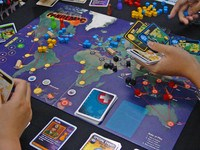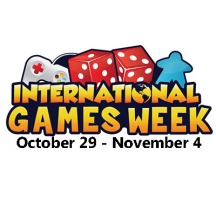By Leanna Fry Balci
Re-posted from Information Today: Europe
(November 17, 2017 ) Traditionally, the role of orienting students to the library has fallen to the library instruction/information literacy (LIIL) section of the BYU Library, and LIIL has required students attending first-year writing (i.e., freshman composition) library sessions to complete a library tour.
How the library tour has evolved
The library tour has taken many forms. For years, students checked out an audio tour and completed a paper-and-pencil quiz. This tour was offered to students outside of library class time and automatically marked them as freshmen to other library patrons. The tour technology evolved from the Walkman to the Discman to the iPod but always had the flavour—albeit unintentionally — of an act of freshmen hazing.
Recently, though, LIIL abandoned technology for a traditional guided tour. During library instruction time, groups of students were led through the library by librarians, teaching assistants, and other personnel. The tour consisted of information about the physical library as well as  discussion of topics like keywords and browsing. Students were required to locate a book via call number (more challenging for students than anyone imagined) and to talk to library personnel at reference desks, the media center, and the research and writing center. The tour got students physically into the library and actually interacting with library services. Overall, this low-tech approach was a success but ultimately deemed unsustainable due to the number of employees required to guide approximately 2,500 students a semester.
discussion of topics like keywords and browsing. Students were required to locate a book via call number (more challenging for students than anyone imagined) and to talk to library personnel at reference desks, the media center, and the research and writing center. The tour got students physically into the library and actually interacting with library services. Overall, this low-tech approach was a success but ultimately deemed unsustainable due to the number of employees required to guide approximately 2,500 students a semester.
Using AR to offer an interactive experience
With the goal of not only getting students into the library but getting them back into the building after their first-year library experience, LIIL is now exploring ARIS technology. Augmented Reality may be familiar to some in the form of the gaming app Pokémon Go. This technology replaces the traditional tour with an experience.
Students download an app that allows them to interact with different areas of the library, collect points, and earn rewards. ARIS includes GPS, which allows for player location and in-game placement of items. Students can walk to the items and interact with them as well as with other players. ARIS allows users to upload media for in-game uses such as videos, music, and pictures. For example, students may locate a help desk on the map and then activate a brief video giving information about that location.
Other features of ARIS include the ability to scan and read QR codes for easy logins and the ability to turn a photograph or object in the physical space into an interaction in the game. For example, scanning a 2-D map of the library brings up the map in a 3-D format, giving students a different perspective of the physical space.
In order to gamify the experience, ARIS allows for embedded javascript and the creation of items such as a leaderboard (right). Students are able to collect points during different stops and interactions in order to compete with other users. This sense of competition may be appealing to some students and encourage additional use of the app and visits to the library.
Despite the interactions offered by ARIS, it also has definite limitations. Because it is an open source software, development progresses slowly. For example, it is currently only available in iOS, although an android version is promised in the future. Because of this limitation, the library offers students iPods already loaded with the app. However, not having the app downloaded on an individual’s device discourages students from returning to the library to continue the experience. The GPS also has limitations in accuracy. Bluetooth beacons, however, have been used to rectify this problem, acting as location triggers. In addition, the BYU Library is fortunate to employ several students with the skills and capabilities to make this app a reality, something that may not be possible at all libraries due to funding.
User feedback is currently being gathered and assessment of the app will determine expansion of experiences offered to students beyond the traditional first-year library orientation tour. Thus far, though, the technology seems promising as an interactive way to invite students into the library.
Leanna Fry Balci works at the Library, Brigham Young University (BYU), USA.
 In my constant search for anything to do with games and libraries I have been seeking podcasts. Right out of the gate I scored a direct hit and came across this great podcast. Who knows how I missed it all this time. The podcast is hosted and edited by Stephanie Frey who is the Teen Games & Technology Assistant at the Waccamaw Neck Branch Library Teen Room of the Georgetown County Library System in Pawleys Island, South Carolina. Which, as it turns out is only a few score miles from where I am in Charleston. The podcast discuss everything remotely associated with games and gaming and schools and libraries. Recent topics included Games and Art, Developing Literacy Skills Using Games, Gamification Designing Meaningful Games for an Older Audience, Utilizing Simulations in the Classroom, Converting Games Into Instructional Tools, and Using Games to Help Special Needs Students with Social Skills.
In my constant search for anything to do with games and libraries I have been seeking podcasts. Right out of the gate I scored a direct hit and came across this great podcast. Who knows how I missed it all this time. The podcast is hosted and edited by Stephanie Frey who is the Teen Games & Technology Assistant at the Waccamaw Neck Branch Library Teen Room of the Georgetown County Library System in Pawleys Island, South Carolina. Which, as it turns out is only a few score miles from where I am in Charleston. The podcast discuss everything remotely associated with games and gaming and schools and libraries. Recent topics included Games and Art, Developing Literacy Skills Using Games, Gamification Designing Meaningful Games for an Older Audience, Utilizing Simulations in the Classroom, Converting Games Into Instructional Tools, and Using Games to Help Special Needs Students with Social Skills. 


 The
The 

 discussion of topics like keywords and browsing. Students were required to locate a book via call number (more challenging for students than anyone imagined) and to talk to library personnel at reference desks, the media center, and the research and writing center. The tour got students physically into the library and actually interacting with library services. Overall, this low-tech approach was a success but ultimately deemed unsustainable due to the number of employees required to guide approximately 2,500 students a semester.
discussion of topics like keywords and browsing. Students were required to locate a book via call number (more challenging for students than anyone imagined) and to talk to library personnel at reference desks, the media center, and the research and writing center. The tour got students physically into the library and actually interacting with library services. Overall, this low-tech approach was a success but ultimately deemed unsustainable due to the number of employees required to guide approximately 2,500 students a semester.
 Original Site:
Original Site: 